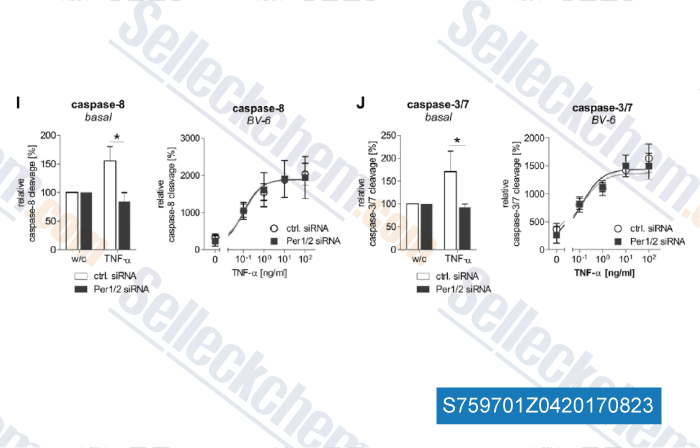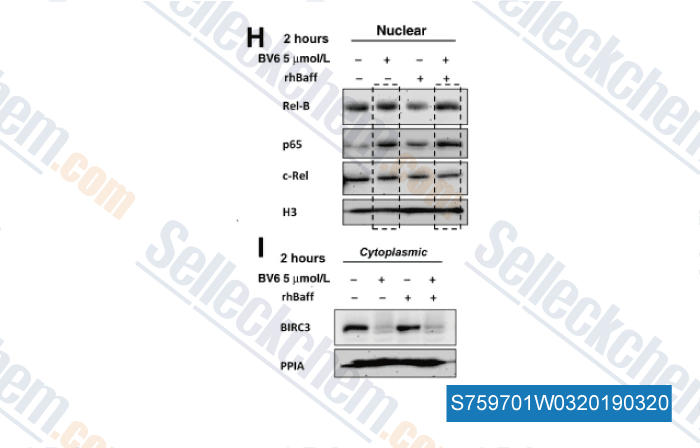|
Toll Free: (877) 796-6397 -- USA and Canada only -- |
Fax: +1-832-582-8590 Orders: +1-832-582-8158 |
Tech Support: +1-832-582-8158 Ext:3 Please provide your Order Number in the email. |
Technical Data
| Formula | C70H96N10O8.xCF3COOH |
||||||||||
| Molecular Weight | 1205.57 | CAS No. | 1001600-56-1(freebase) | ||||||||
| Solubility (25°C)* | In vitro | DMSO | 100 mg/mL (82.94 mM) | ||||||||
| Water | 100 mg/mL (82.94 mM) | ||||||||||
| Ethanol | 100 mg/mL (82.94 mM) | ||||||||||
| In vivo (Add solvents to the product individually and in order) |
|
||||||||||
|
* <1 mg/ml means slightly soluble or insoluble. * Please note that Selleck tests the solubility of all compounds in-house, and the actual solubility may differ slightly from published values. This is normal and is due to slight batch-to-batch variations. * Room temperature shipping (Stability testing shows this product can be shipped without any cooling measures.) |
|||||||||||
Preparing Stock Solutions
Biological Activity
| Description | BV-6 is a SMAC mimetic, dual cIAP and XIAP inhibitor. | ||
|---|---|---|---|
| Targets |
|
||
| In vitro | BV6 inhibits the cell viability of HCC193 NSCLC cells with IC50 of 7.2 μM, induces apoptosis in both HCC193 and H460 cell lines, and also significantly enhances the radiosensitivity of these cell lines through activation of cleaved caspase-8 and cleaved caspase-9, respectively. [1] In immature dendritic cells, this compound treatment results in moderate activation of the classical NF-kB pathway. [2] Furthermore, it increases CIK cell-mediated lysis of hematological (H9, THP-1, and Tanoue) and solid malignancies (RH1, RH30, and TE671). This chemical also enhances apoptosis of peripheral blood mononuclear cells and most notably has an inhibitory effect on immune cells limiting their cytotoxic potential. [3] |
||
| In vivo | BV6 is an IAP antagonist. |
Protocol (from reference)
| Cell Assay: |
|
|---|---|
| Animal Study: |
|
References
|
Customer Product Validation

-
, , FASEB J, 2017, 31(11):4707-4719

-
Data from [ , , Clin Cancer Res, 2018, doi:10.1158/1078-0432.CCR-18-1548 ]
Selleck's BV-6 Has Been Cited by 81 Publications
| Ferroptosis-activating metabolite acrolein antagonizes necroptosis and anti-cancer therapeutics [ Nat Commun, 2025, 16(1):4919] | PubMed: 40425585 |
| Shigella type-III secretion system effectors counteract the induction of host inflammation and cell death [ EMBO J, 2025, 10.1038/s44318-025-00561-7] | PubMed: 40931196 |
| The cancer-associated SF3B1K700E spliceosome mutation confers enhanced sensitivity to BV-6-induced cytotoxicity [ Cell Death Dis, 2025, 16(1):476] | PubMed: 40595498 |
| Anti-inflammatory mechanism of the MLKL inhibitor necrosulfonamide in LPS- or poly(I:C)-induced neuroinflammation and necroptosis [ Biochem Pharmacol, 2025, 239:117021] | PubMed: 40473224 |
| Adenosine triphosphate-binding pocket inhibitor for mixed lineage kinase domain-like protein attenuated alcoholic liver disease via necroptosis-independent pathway [ World J Gastroenterol, 2025, 31(6):96782] | PubMed: 39958438 |
| Linear ubiquitination prevents lipodystrophy and obesity-associated metabolic syndrome [ Sci Adv, 2025, 11(38):eadw2539] | PubMed: 40961178 |
| Lymph node and tumor-associated PD-L1+ macrophages antagonize dendritic cell vaccines by suppressing CD8+ T cells [ Cell Rep Med, 2024, 5(1):101377] | PubMed: 38232703 |
| RIPK1 protects naive and regulatory T cells from TNFR1-induced apoptosis [ Cell Death Differ, 2024, 10.1038/s41418-024-01301-w] | PubMed: 38734851 |
| Starvation-induced phosphorylation activates gasdermin A to initiate pyroptosis [ Cell Rep, 2024, 43(9):114728] | PubMed: 39264808 |
| The cell cycle inhibitor p21CIP1 is essential for irinotecan-induced senescence and plays a decisive role in re-sensitization of temozolomide-resistant glioblastoma cells to irinotecan [ Biomed Pharmacother, 2024, 181:117634] | PubMed: 39489121 |
RETURN POLICY
Selleck Chemical’s Unconditional Return Policy ensures a smooth online shopping experience for our customers. If you are in any way unsatisfied with your purchase, you may return any item(s) within 7 days of receiving it. In the event of product quality issues, either protocol related or product related problems, you may return any item(s) within 365 days from the original purchase date. Please follow the instructions below when returning products.
SHIPPING AND STORAGE
Selleck products are transported at room temperature. If you receive the product at room temperature, please rest assured, the Selleck Quality Inspection Department has conducted experiments to verify that the normal temperature placement of one month will not affect the biological activity of powder products. After collecting, please store the product according to the requirements described in the datasheet. Most Selleck products are stable under the recommended conditions.
NOT FOR HUMAN, VETERINARY DIAGNOSTIC OR THERAPEUTIC USE.
